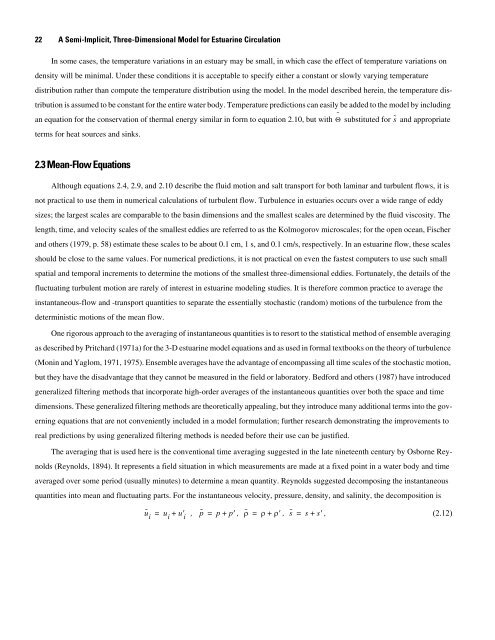A Semi-Implicit, Three-Dimensional Model for Estuarine ... - USGS
A Semi-Implicit, Three-Dimensional Model for Estuarine ... - USGS
A Semi-Implicit, Three-Dimensional Model for Estuarine ... - USGS
You also want an ePaper? Increase the reach of your titles
YUMPU automatically turns print PDFs into web optimized ePapers that Google loves.
22 A <strong>Semi</strong>-<strong>Implicit</strong>, <strong>Three</strong>-<strong>Dimensional</strong> <strong>Model</strong> <strong>for</strong> <strong>Estuarine</strong> Circulation<br />
In some cases, the temperature variations in an estuary may be small, in which case the effect of temperature variations on<br />
density will be minimal. Under these conditions it is acceptable to specify either a constant or slowly varying temperature<br />
distribution rather than compute the temperature distribution using the model. In the model described herein, the temperature dis-<br />
tribution is assumed to be constant <strong>for</strong> the entire water body. Temperature predictions can easily be added to the model by including<br />
an equation <strong>for</strong> the conservation of thermal energy similar in <strong>for</strong>m to equation 2.10, but with Θ ˜ substituted <strong>for</strong> s˜ and appropriate<br />
terms <strong>for</strong> heat sources and sinks.<br />
2.3 Mean-Flow Equations<br />
Although equations 2.4, 2.9, and 2.10 describe the fluid motion and salt transport <strong>for</strong> both laminar and turbulent flows, it is<br />
not practical to use them in numerical calculations of turbulent flow. Turbulence in estuaries occurs over a wide range of eddy<br />
sizes; the largest scales are comparable to the basin dimensions and the smallest scales are determined by the fluid viscosity. The<br />
length, time, and velocity scales of the smallest eddies are referred to as the Kolmogorov microscales; <strong>for</strong> the open ocean, Fischer<br />
and others (1979, p. 58) estimate these scales to be about 0.1 cm, 1 s, and 0.1 cm/s, respectively. In an estuarine flow, these scales<br />
should be close to the same values. For numerical predictions, it is not practical on even the fastest computers to use such small<br />
spatial and temporal increments to determine the motions of the smallest three-dimensional eddies. Fortunately, the details of the<br />
fluctuating turbulent motion are rarely of interest in estuarine modeling studies. It is there<strong>for</strong>e common practice to average the<br />
instantaneous-flow and -transport quantities to separate the essentially stochastic (random) motions of the turbulence from the<br />
deterministic motions of the mean flow.<br />
One rigorous approach to the averaging of instantaneous quantities is to resort to the statistical method of ensemble averaging<br />
as described by Pritchard (1971a) <strong>for</strong> the 3-D estuarine model equations and as used in <strong>for</strong>mal textbooks on the theory of turbulence<br />
(Monin and Yaglom, 1971, 1975). Ensemble averages have the advantage of encompassing all time scales of the stochastic motion,<br />
but they have the disadvantage that they cannot be measured in the field or laboratory. Bed<strong>for</strong>d and others (1987) have introduced<br />
generalized filtering methods that incorporate high-order averages of the instantaneous quantities over both the space and time<br />
dimensions. These generalized filtering methods are theoretically appealing, but they introduce many additional terms into the gov-<br />
erning equations that are not conveniently included in a model <strong>for</strong>mulation; further research demonstrating the improvements to<br />
real predictions by using generalized filtering methods is needed be<strong>for</strong>e their use can be justified.<br />
The averaging that is used here is the conventional time averaging suggested in the late nineteenth century by Osborne Rey-<br />
nolds (Reynolds, 1894). It represents a field situation in which measurements are made at a fixed point in a water body and time<br />
averaged over some period (usually minutes) to determine a mean quantity. Reynolds suggested decomposing the instantaneous<br />
quantities into mean and fluctuating parts. For the instantaneous velocity, pressure, density, and salinity, the decomposition is<br />
ũ i<br />
= u<br />
i<br />
+ u′<br />
i<br />
, p˜ = p + p′ , ρ˜ = ρ + ρ′ , s˜ = s + s′ , (2.12)

















